Ancient Rome
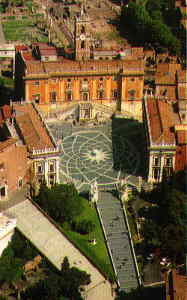
The Campidoglio
Begin your walk on the Campidoglio -- the Capitoline Hill -- famed as the site of Michelangelo's spectacular Piazza del Campidoglio and Rome's ceremonial city hall, Palazzo Senatorio. First head around the Palazzo to the belvederes situated along the sides of the building to gaze down on what was once the center of the known world: the Roman Forum. The Palatine Hill and the Colosseum loom in the background.
Back in center of the piazza, head to the right of the replica of the ancient bronze statue of Marcus Aurelius and the Musei Capitolini, home to one of the city's finest and most famous collections of ancient sculpture and Baroque painting. Off the southeast flank of Palazzo Nuovo, head to the formidable flight of steps that leads up to the ancient redbrick church of Santa Maria di Aracoeli, the national church of Italy.
From the southwest flank of Palazzo Senatorio, take Via del Campidoglio and then Via del Tempio di Giove for a look at the Roman Forum from the Belvedere Tarpeo, the Tarpean Rock, from which prisoners were dispatched in ancient times; try to imagine what the area looked like when most of these magnificent ruins were covered over by marshy pastureland, and cows grazed beside half-buried columns and trod on 2,000-year-old marble paving slabs. From the belvedere on the northeast side of Palazzo Senatorio, descend Via San Pietro in Carcere, which is actually a flight of stairs, to the gloomy Carcere Mamertino, once prison to St. Peter and the Gaul warrior, Vercingetorix.
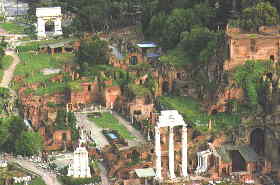
The Roman Forum
Head for Via dei Fori Imperiali and the entrance to the Foro Romano. Here you can find what remains of the various buildings in the Forum: the Basilica Emilia, which was not a church but a grand civic hall; the Curia, where the Senate met and one of the most complete buildings of ancient Rome still standing; and the Comitium rostrum, where Mark Antony eulogized Caesar. Although the Arco di Settimio Severo -- the most spectacular arch of triumph extant from antiquity -- the remaining columns of the Tempio di Vespasiano (Temple of Vespasian), and the Colonna di Foca rise above the ruins, the Basilica Giulia is little more than a large raised platform. The Tempio di Cesare (Temple of Caesar), on the spot where Caesar was cremated, is hardly distinguishable. The Tempio di Antonino e Faustina met with better luck; incorporated into a church, its column front has been well preserved. Nearby are the three famous columns of the partially reconstructed, round Tempio di Vesta. The Tempio di Castore e Polluce and the Fonte di Giuturna have to be imagined, as little is left of them. Off to one side, you can see, but not visit, the church of Santa Maria Antiqua, built into what was originally a vestibule of the imperial palace on the Palatino.
Stroll east along the Via Sacra, and turn left into the Basilica di Massenzio, built by Emperor Maxentius to be one of the grandest meeting halls of ancient times. The 10th-century church of Santa Francesca Romana stands atop a rise next to the basilica. The Via Sacra ends at the Arco di Tito, the triumphal arch built by Emperor Titus and famed for its carved menorah (recalling Rome's recapture of Jerusalem after the great Jewish revolt). The Tempio di Venere e Roma, one of the projects of the architecturally savvy emperor Hadrian, was begun on the site of the vast vestibule of Nero's grandiose Domus Aurea in AD 121.
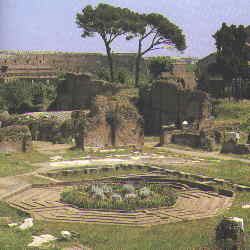
The Palatine Hill
There are few more atmospheric places in Rome to wander about in than the Palatine Hill, with its hidden corners and shady lanes. To visit its ruins in roughly chronological order, start from the southeast area facing the Aventine. The Belvedere offers panoramic views of the famous Roman arena, the Circo Massimo (Circus Maximus), the green slopes of the Aventine and Celian hills, and the picturesque bell tower of Santa Maria in Cosmedin. You can then proceed to the Museo Palatino or the adjacent Iron Age Capanne Arcaiche settlement, moving on to the temples there and to the legendary Casa di Livia, no less the house of the wife of Emperor Augustus. Then visit the ruins of two more grand palaces, the Domus Augustana and the Domus Flavia, taking in the Stadio Palatino, before winding up at the lovely Orti Farnesiani gardens, overlooking the Forum and the Capitoline Hill.
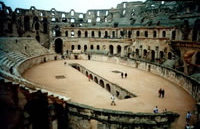
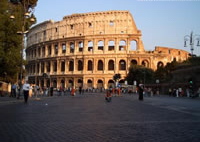
The Colosseum
The exit of the Palatino leads to the Arch of Titus, where you turn east toward the Colosseum. To the right is the Arco di Costantino (Arch of Constantine). Next, you can explore the Colosseo (Colosseum), one of antiquity's most celebrated monuments. Cross Piazza del Colosseo and stroll through the park on the Colle Oppio (Oppian Hill), where most of Nero's fabulous palace, the Domus Aurea (Golden House), is hidden under the remains of the monumental baths that were built over it. The park has some good views over the Colosseum; one of the best vantage points is from Via Nicola Salvi, which climbs uphill from the Colosseum.
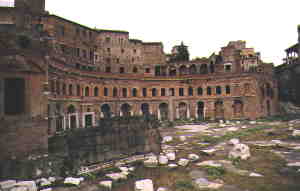
The Imperial Forums
From Piazza del Colosseo, head northwest on Via dei Fori Imperiali toward Piazza Venezia. On the walls to your left, maps in marble and bronze put up by Benito Mussolini show the extent of the Roman Republic and Empire. The dictator's own dreams of empire led him to construct this avenue, cutting brutally through the Imperial Fora area, so that he would have a suitable venue for parades celebrating his expected military triumphs. Beginning in the 1990s, part of the historical neighborhood ravaged by Mussolini has been revealed by new digs. Beyond the ancient brick walls behind the Imperial Fora lay the Suburra, the mean streets of ancient Rome, where the plebs lived in crowded tenements. Opposite the brick wall, look through an archway into the huge Basilica di Massenzio. Next door is the church of Santi Cosma e Damiano, a little gem that started life as a library in the Forum of Vespasian and holds a marvelous early Christian mosaic. Among the Fori Imperiali along the avenue you can see the Foro di Cesare (Forum of Caesar) and the Foro di Augusto (Forum of Augustus). The grandest of all the Imperial Fora was the Foro di Traiano (Forum of Trajan), with its huge semicircular Mercati Traianei and the Colonna di Traiano (Trajan's Column).